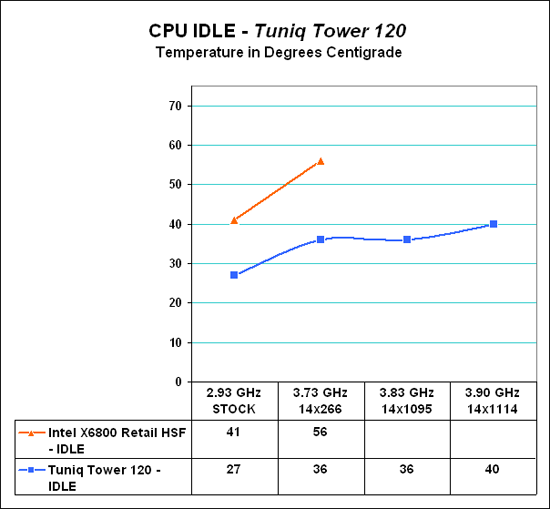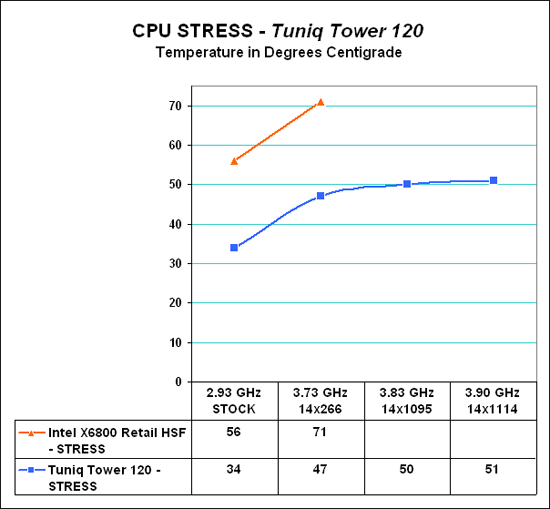Tuniq Tower 120: Air Cooling to the Max
by Wesley Fink on January 15, 2007 12:01 AM EST- Posted in
- Cases/Cooling/PSUs
Cooling Results
Both the retail Intel X6800 HSF and the Tuniq Tower 120 perform well at idle. Even at this base level, however, the effectiveness of the Tuniq Tower 120 is still clear.
Where the very good Intel stock cooler keeps the X6800 at 41C, the Tuniq manages 27C, which is a huge difference at stock idle speeds. As the processor is pushed to its highest stable overclock using the retail HSF, the delta increases. At 3.73GHz the retail HSF is running at 56C, compared to an extremely cool 36C with the Tuniq at the same speed. The Tuniq allows the X6800 to reach even higher overclocks, to a stable 3.90 GHz. Even at the maximum overclock on this CPU with the Tuniq, idle temperature is still a modest 40C, less than the stock speed temperature of the retail Intel HSF.
It is very easy to measure the effectiveness of a cooling solution at idle - when the computer is doing nothing except running the temperature measurement program. It is more difficult, however, to effectively simulate a computer being stressed by all of the conditions it might be exposed to in different operating environments. Frankly, for most home users CPU power is most taxed with contemporary gaming. Therefore our stress test simulates running a demanding contemporary game.
The Far Cry River demo is looped for 30 minutes and the CPU temperature is captured at 4 second intervals with the NVIDIA monitor "logging" option. The highest temperature during the stress test is then reported. We did try other variations in "stressing" the CPU. One option was multi-tasking running Super Pi with the Far Cry River looping. This did almost halve gaming frame rates and push CPU utilization to near a constant 100%. The multitasking test setup, however, did not produce higher temperatures than looping the Far Cry River demo. For that reason, we settled on the simple stress test of looping a demanding Far Cry demo for 30 minutes.
Cooling effectiveness compared to the retail HSF improves even more with the Tuniq Tower 120 when measured under stress conditions. It appears the Tuniq becomes even more effective as greater demands are placed on cooling.

The delta under stress conditions at stock 2.93GHz speed is 22C - 56C to 34C. This compares to the delta at stock idle of 14C. As we saw with idle speeds, the difference increased as we overclocked, with a difference of 24C (71C to 47C) at the 3.73GHz overclock. With the Tuniq speed could be pushed another 170 MHz to 3.90 GHz, with the stress CPU temperature of 51C - still 5C below the stress temperature of the retail HSF at stock speeds.
It would be an understatement to say the performance of the Tuniq 120 is impressive in cooling the CPU. In all cases the Tuniq cooled the CPU better than the stock Intel retail HSF under the same conditions at stock speed. This was true even with the X6800 pushed about 1000MHz beyond the fastest available Core 2 Duo CPU.
As for the overclocking abilities of the CPU, they will vary at the top. This particular CPU does higher FSB speeds than any X6800 we have tested, but the 3.9GHz top speed is pretty average among this CPU cooled with the Tuniq Tower 120. A few of the other processors tested with the Tuniq reach just over 4 GHz, but the range has been 3.8 to 4.0GHz. Stock cooling generally tops out 200 to 400Mhz lower, depending on the CPU, on the processors tested in our lab.










50 Comments
View All Comments
monsoon - Monday, January 15, 2007 - link
Hello,I was a little surprised not tp see comparison benchmarks to a TUNIQ + E4300. I would love to see how much higher can the little buddy be pushed to a overclock with a TUNIQ.
Also, how comes lower clocked CPUs are those that can get higher ? ( sorry, I'm a newbie to PC modding )
THANKS
Great Googly Moogly - Monday, January 15, 2007 - link
Do not use the word "silent"; use "quiet". Also, you'd do better if you at least gave some impressions of the quality of noise, as that is just as, if not more, important.The rest is good.
RobbieMc - Monday, January 15, 2007 - link
I recently purchased a Scythe Ninja to cool a QX6700. I was considering purchasing the Tuniq Tower, or the Ninja, and was told the ninja had slightly better cooling. After installing it (properly), I found that the Ninja ran nearly 30 degrees F hotter than the stock cooling. I was under the impression that the Ninja and the Tuniq Tower had about the same performance, but based on this review, if my data is right, then the Tuniq would be much better. I'm wondering what the weak link is with the ninja. Is it really possible that the stock cooling is substantially better? Do you all suspect I had an improper installation (I am convinced I did everything properly), is the Tuniq better than the Ninja, are my results at all normal? Thanks.xsilver - Monday, January 15, 2007 - link
http://www.madshrimps.be/?action=getarticle&nu...">http://www.madshrimps.be/?action=getart...ber=2&am...a non obvious installation problem is too much thermal grease
either that or malfunctioning probes?
RobbieMc - Monday, January 15, 2007 - link
The first time installing, I did put on WAY too much thermal grease, but I soon realized this was bad, and reinstalled it with a very thin layer of Arctic Silver 5 grease. I don't think the probes are bad either because the temperature readings I'm getting are within 1-2 degrees of Anandtech's stock cooler temperatures (131F under load).Shark Tek - Monday, January 15, 2007 - link
Those stock temps are quite high if I compare them to my 939 AMD 4400+ X2 setup. At 2.8GHz I run 35'C idle and 50'C load.Which is the maximum or limit temp that a Core Duo 2 can stand in such way that it will work flawlessly? I mean, in which point you need to worry about temperature?
Wesley Fink - Monday, January 15, 2007 - link
How are you measuring temperatures? Most motherboards are notoriously inaccurate in CPU temp measurements.Zaitsev - Monday, January 15, 2007 - link
Great review, Wesley. I'm so happy that Anandtech is finally testing cooling solutions again. It would be nice if you could comment on the weight of the heavier coolers in the next article, since that is a common complaint about heatsinks like the tuniq tower or infinity. Look forward to the rest of the series.mobutu - Monday, January 15, 2007 - link
I suggest that Anandtech take a look at http://www.silentpcreview.com/">http://www.silentpcreview.com/ and learn how to do a "noise" test. If 34db is quiet then how about 22-25db? Definitevly 34db is LOUD.Otherwise pretty good review, but to compare aplle with aplle then you should test at least Thermalright Ultra 120 and Scythe Ninja (not to mention similar solutions from zalman, thermaltake and the others).
Cheers!
Wesley Fink - Monday, January 15, 2007 - link
We are very aware of some of the excellent "noise level" testing done by Silent PC. The information is very useful for those who are looking for the lowest possible noise.However, all our benchmarking tries to factor in the "real world" where users are operating their computers. The real world in this case is a "subjectively" very quiet 520W OCZ Power Supply at a noise floor of 38.3db and our test room at 36.3 db with all computers and fans turned off. To mainteain noise in the mid-30's we have to leave off all other computers, ac, and heat in the lab during our sound measurements. At those db levels, performance at 24db is interesting, but it doesn't tell us much about the noise of a cooler in a working computer in our test room.